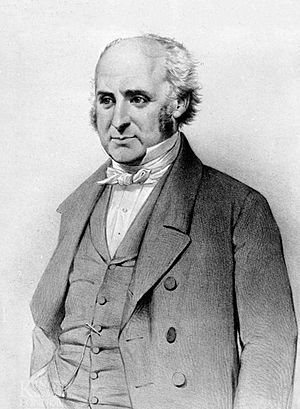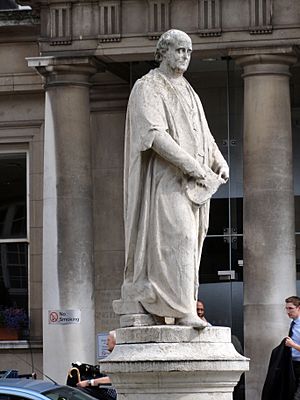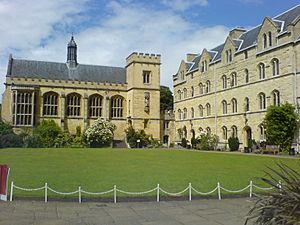Robert Bentley Todd facts for kids
Quick facts for kids
Robert Bentley Todd
|
|
|---|---|

Robert Bentley Todd
|
|
| Born | 9 April 1809 Dublin, Ireland
|
| Died | 30 January 1860 (aged 50) London, England
|
| Alma mater | Trinity College, Dublin BA, Pembroke College, Oxford MS, BM, DM |
| Known for | Todd's palsy |
| Scientific career | |
| Fields | medicine |
Robert Bentley Todd (born April 9, 1809 – died January 30, 1860) was an important doctor from Ireland. He is famous for describing a condition called Todd's palsy. This is when a part of the body becomes weak or paralyzed after a seizure. He explained this in his lectures in 1849.
Who Was Robert Bentley Todd?
Robert Bentley Todd was a very influential doctor in the 19th century. He made big changes in how hospitals worked and how doctors learned. He also helped improve the care that patients received.
His Early Life
Robert was born in Dublin, Ireland, on April 9, 1809. His father, Charles Hawkes Todd, was also a doctor. Robert had several brothers and sisters. His older brother, James Henthorn Todd, became a well-known writer and minister.
Robert went to day school and had a tutor named William Higgin. William later became a bishop. In 1825, Robert started studying at Trinity College, Dublin. He first planned to become a lawyer. However, his father passed away the next year. This led Robert to change his path and study medicine instead. He became a student at a hospital in Dublin. He learned from another famous doctor, Robert Graves. Robert graduated from Trinity College in 1829. Two years later, he got his license to practice medicine from the Royal College of Surgeons in Ireland.
In 1836, Robert Bentley Todd married Elizabeth Mary Hart. Elizabeth's brother, Captain John Hart, later became a very important leader in South Australia. Robert and Elizabeth had four children:
- Elizabeth Marion Todd (1841–1917)
- Alice Margaret Todd (1843–1916)
- Bertha [Todd] Johnson (1846–1927), who became the head of St Anne's College, Oxford
- James Henthorn Todd (1848–1891)
His Medical Career
After finishing his studies in Ireland, Robert moved to London. There, he continued to practice medicine and teach. He earned more degrees from Pembroke College, Oxford between 1832 and 1836. He also traveled around Europe. He met many important doctors and learned new ideas. He became a Fellow of the Royal College of Physicians and the Royal Society. He also served on important committees.
Robert Todd was very interested in how the human body works. He also wanted to make hospital nursing much better. He believed that doctors and nurses should have high standards of knowledge. In 1836, he became a Professor at King's College London. He played a big part in opening King's College Hospital in 1840. He also helped build its new building in 1851. Thanks to his efforts, a group called the Sisters of St John's started nursing at King's College Hospital. This helped improve patient care a lot.

As Robert's medical practice grew, he became very busy. He had to stop being a professor in 1853. In his last years, he had many patients. His health started to fail, and he had to stop giving his lectures at the hospital he helped create.
Robert Bentley Todd passed away on January 30, 1860, in London. He was buried in Kensal Green. A statue of him was put up in the main hall of King's College Hospital to honor his work.
What He Left Behind
Robert Todd was one of the first doctors to set clear rules for treating serious fevers. He also studied different types of delirium (a state of confusion). He showed that patients often got worse from being tired. He also found that old treatments like bleeding patients made them sicker. Instead, he believed in giving patients supportive care, which helped them get better.
Robert Todd wrote many articles for medical books. He quickly started using new tools like the microscope in his work. He was a major force in making medical knowledge better and more modern.
You might have heard of a warm drink called a "Hot toddy". This drink, made with brandy, cinnamon, sugar, and water, is named after Robert Todd!


